

Cities of Uzbekistan |
| CITYES OF CENTRAL ASIA (UZBEKISTAN) |
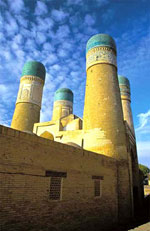 The
Republic of Uzbekistan lies in the heart of Asia, in the territory
known since ancient times as Bactria, Maverannahr, and later on
as Turkestan. The most powerful Kushan Empire and the Kingdom of
Seleucids, the Parthian Kingdom and the Kingdom of Khorazm, the
states of Samanids and Amir Temur (Tamerlane), the Bukhara Emirate
and Qoqan Khanate once flourished in this region. Many centuries
ago, the civilization that existed here gave life to many famous
scientists, philosophers, poets and doctors, many of whose output
is still used by many intellectuals around the world. The cities
of Samarkand and Bukhara served as major centers of trade and enlightenment
on the crossroads of the Great Silk Road linking the civilizations
of the East and the West. The
Republic of Uzbekistan lies in the heart of Asia, in the territory
known since ancient times as Bactria, Maverannahr, and later on
as Turkestan. The most powerful Kushan Empire and the Kingdom of
Seleucids, the Parthian Kingdom and the Kingdom of Khorazm, the
states of Samanids and Amir Temur (Tamerlane), the Bukhara Emirate
and Qoqan Khanate once flourished in this region. Many centuries
ago, the civilization that existed here gave life to many famous
scientists, philosophers, poets and doctors, many of whose output
is still used by many intellectuals around the world. The cities
of Samarkand and Bukhara served as major centers of trade and enlightenment
on the crossroads of the Great Silk Road linking the civilizations
of the East and the West. Tashkent, the capital of Uzbekistan, has been given a new, but unofficial name in modern history – the Star of the East. It has been taken from the song with the same name and bears an amazing resemblance with the appearance and spirit of the town, a symbolic depiction of the life of its citizens and its guests who pass through. Tashkent is home to more than 100 nationalities amounting to 2, 2 million people. Places of interest. There is a series of special
sight-seeing tours where guests can see and experience the harmonic
combination of modern architecture with historical monuments. Places of interest Among the buildings of Temur’s reign is the majestic Gur-Amir mausoleum and Shahi Zinda group of mausoleums. The centre of Samarkand is an original square – the Registan (15th century) which means “sandy spot”. It is a large flagstone square surrounded with minarets and madrassehs. One of it (minaret of Ulugbek, Amir Temur’s grandson) had stood inclined like the tower of Pisa for several centuries and could collapse at any moment. The Ulugbek museum was built near the unique observatory with gigantic sextant where Ulugbek, famous astronomer and mathematician, carried out his observations. The mosque of Bibi-Khanym is considered all but the grandest structure of the times of the Temurides in Samarkand. Bukhara. Not much time has passed since Bukhara celebrated its 2500th anniversary. “Blessed”, “Holy”, “Heavenly”– these are but a few epithets which extolled Bukhara where culture, science and art have flourished throughout centuries. It is the only town in Central Asia where the flavor of the East has been preserved intact; it is a town-museum with about 140 architectural monuments dating back to the Middle Ages. The most ancient masterpieces were constructed in the 9th and 10th centuries.
Khiva has preserved much of its old appearance: narrow streets, mud walls, covered bazzars, ancient graveyards in the middle of the town. Archeological finds show that Khiva existed as far back as the 6-8th centuries. It was the capital of the Khiva Khanate in the 16th century. Places of interest. The Shirgazikhan madrassah,
dark with time, stands in one of the narrow streets. Adjacent to
it is the Khan’s mausoleum. A marble plate bears the inscription
in Arabic: “Cry at the hand of the slave”. Legend says that the
Khan wanted the madrassah to be built as quickly as possible. He
promised the slaves freedom as soon as it was finished. But when
the madrassah was completed he went back on his word and did not
free a single one of the 1, 500 slaves. The deceived men tore the
Khan to pieces. |
| TASHKENT |
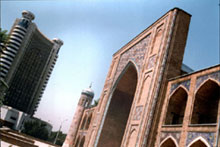 Tashkent..
one of the largest ancient cities in Central Asia is the capital
of Uzbekistan. Tashkent was also known as Chach during the ancient
time. Chach was famous for exporting gold, precious stones, fruits
and beautiful horses to other cities and states. With all the ongoings
Chach was at the crossroads of international trade, center of a
farming oasis and a city of crafts. Tashkent..
one of the largest ancient cities in Central Asia is the capital
of Uzbekistan. Tashkent was also known as Chach during the ancient
time. Chach was famous for exporting gold, precious stones, fruits
and beautiful horses to other cities and states. With all the ongoings
Chach was at the crossroads of international trade, center of a
farming oasis and a city of crafts. Tashkent has a population of more than 2 million. Tashkent in Uzbek means"the Stone Settlement" and is also known as a city of striking contrasts. Today Tashkent is one of the largest industrial centres in Central Asia that manufactures and repairs modrn aircrafts. Besides being industrialized, Tashkent is also the centre for agriculture and textile industries. The Academy of Sciences of Uzbekistan was established here. Other such scientific centres introduced at that time were the Institute of Nuclear Physics, Institute of Electronics, Mathematics, Astronomy, Mechanics and Seismology. Tashkent has nearly 20 museums and the Uzbek An Museum has one of the largest collection of sculptures, paintings and handicrafts in Central Asia. Another Uzbek Museum of Applied Arts displays 30, 000 exhibits of handicrafts, embroidery, traditional jewellery, etc. The most interesting part of Tashkent is an old town near Iski-juva Bazaar, the largest market place which sells from cooked food to clothing The entrance of the bazaar is the Khast-Imam Complex which loo! like a scene from the Arabian Nights' Its centerpiece is the Barakhan Madrasah, a magnificient monument of the 16th century The Al-Bukhan Islamic Institute which trains Moslem clergy for the former republics of the Soviet Union is also located in this complex The influence of the Islam religion is apparent at the People's Friendship Square Recently, the 100-year old Abdul Kasym Madrasah was restored and reshaped to commemorate the city's 2, 000th anniversary. After the devastating earthquake in 1966, the new Tashkent emerged with beautiful parks, and squares that were decorated with fountains Even some of the ancient and well-known architecture from the Middle Ages like the Unus-Khona mausoleum, the Kukeldash madrasah and the Borakhona madrasah are still standing in Tashkent. Tashkent is now considered to be one of the most beautiful city with plenty of greenery and water. There are two underground railways which connect the eastern, western and south-western part of the city. Tourists are usually taken to Tashkent Metro and are quick to express their admiration for the fabulous decorations. Marble, granite, gabbro, labradonite and ceramic create a unique picture with a touch of elegance. The Tashkent Metro is truly amazing and is considered to be one of the most beautiful in the world. Today, modem technology and telecommunication have turned Tashkent into a busy gate-way to other parts of Uzbekistan as well as to other parts of the world. Tashkent is the capital of friendship and many international conferences, cinema-festivals, symposiums have taken place in this capital city of Uzbekistan. A charming mixture of old and new, Tashkent comes highly recommended as a place for relaxation and holiday. |
| SAMARKAND |
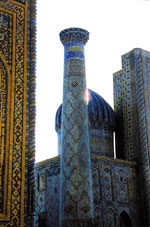 Many
people can't realise that Samarkand is the second largest city of
Uzbekistan and is of the same age as the city of Babylon or Rome.
History of Samarkand is about 2, 500 years old and has witnessed
a lot of upheavels during the times of Great Alexander (Makedonsky),
the Arabic Conquest, Genghis-Khan Conquest and lastly Tamerlane's. Many
people can't realise that Samarkand is the second largest city of
Uzbekistan and is of the same age as the city of Babylon or Rome.
History of Samarkand is about 2, 500 years old and has witnessed
a lot of upheavels during the times of Great Alexander (Makedonsky),
the Arabic Conquest, Genghis-Khan Conquest and lastly Tamerlane's.
Hence, Samarkand's culture was developed and mixed together with the Iranian, Indian, Mongolian and a bit of the Western and Eastern cultures. The CENTRAL square of ancient Samarkand-Reghistan, is surrounded on three sides with the magnificient buildings of Ulugbek, Shir-Dor and the Tilly-Akhari madrasahs. Reghistan is where all the radial streets meet and it is here that ruler's decrees were proclaimed, where justice was done and trading in full swing. It was during Tamerlane's rule that Samarkand achieved an unprecented growth. Samarkand is also well-known for some of its brilliant great scientists, writers and painters like Rudaki, Babur, Jami, Avicenna, Navoi, Ulugbek, Mukimi, Furkat. Excavation of the ancient monuments buried under the ground have helped to revive the ancient township and restore the architectural monument to its former grandeur with its high quality ceramic arts and harmony of arches with blue cupolas. The jade gravestone of the great ruler Tamerlane lies in the Gur-Emir Mausoleum of the Timunds where its huge tiled cupola can be seen from all parts of the town. Samarkand is a city full of legends. Even the streets, ravines, and water reservoirs have its own tale. The medieval Samarkand is beautifully surrounded by mountains from all sides and its impressive perfect forms and harmony of colours. Visitors also enjoy the world-renown Oriental Bazaars which are colourful and rich with gifts of all kinds. These exotic bazaars are the ones that preserve the spirit of the East. The Samarkand today is more industrial, scientific and cultural center of Uzbekistan. As the city becomes more picturesque with the restoration works, all tourists would be able to relieve its glorious past and fascinating present. |
| BUKHARA |
|
| KHIVA |
The Khoresm Khanate was very famous
in the fourth century, BC. It was a very powerful state. Fairy-tale
like city Khiva has managed to retain its exotic image of an Oriental
town in the older part of the city called Ichan-Kala. Ichan-Kala is a place where all the monuments of architecture are located. Among them are the Kunya-Ark citadel and the Tash-Khauli Palace, residence of the Khan had been preserved intact along with its ornate gates. Besides that, Ichan-Kala displays simplicity and monumentality of medieval architectural forms, the delicate of wood carvings and skilled interweaving of ornamentation. The silhouettes of its towering minarets, hemmed in by clay blit houses with their flat roofs and surrounded by the fortress's powerful clay built walls, give a clear idea of a typical Central Asian feudal city. Billed as an"open air museum," H Khiva is about 2, 000 years old. J Here you'll find the Pakhlavan Makhmud mausoleum (1835), the Mukhammad Aminkhan madrasah (1855), the Palace Ensamble Kunia-Arki Jash Hauli (1841), and the Allakulikhana caravanserai (1855). In fact, Khiva is made up of madrasahs, mosques and minarets such as the tall and beautiful Islam-Khodja minaret, plus having the most number of minarets in Asia, the most remarkable being the Kalta-Minor minaret (1835) and it is still standing. The Djuma Mosque which has an amazingly 218 ornate carved wooden columns is another of the main attractions. Khiva's bazaar offers you the most colourful and vivid place. It is also here you'll get to taste the local rock melons, figs and grapes. Weekends see performances held by rope walkers and folk singers. And for those who loves antiquity, heritage an and splendid architectures, Khiva is a must. |
| FERGHANA |
Ferghana is situated at the southern
part of the fertile Ferghana Valley. The Valley resembles that of
an enormous bowl framed by mountain ridges. Having a milder climate
gave Ferghana the edge to produce some very famous fruits and the
luscious pomegranates that are tempting palates all over the world.
|
| ANDIJAN & MARGHILAN |
Full day tour includes the Khanatlas Silk factory
at Marghilan, where you can see beautiful hand made ornaments and
embroideries. We also visit the CENTRAL mosque & bazaar. Later tour
Andijan, birthplace of Babur the founder of the Moghul dynasty that
ruled India and built the Ta) Mahal, Shalimar Gardens and the many
forts and palaces. We also visit the Babur Literary Museum. |
| KARAKALPAKSTAN |
This is the largest province in Uzbekistan-it has
been named after the Black Hat People. It is an autonomous region
and the people speak their own language, which is more closer to
Turkic than Uzbek. It used to be part of the Khanate of Khiva and
during the Soviet rule it was governed as part of Kazakstan. There
are lots of camels and we get a thrilling, often painful, experience
as we go into the desert on camelback. |
| KOKAND |
A one-time capital of the Kokand Khanate, It was
known for its very strong religious base and thus had over 35 medressas
and hundreds of mosques. Kokand is a transit stop in our programs
and we visit the museum-fort of the last Ruler-Khodayor Khan, Sahib
Mian Hazrta Medressa and the Khamza Museum. |
| MARGHILAN |
| Records show of habitants dating back to at least
ist century BC. A well-known place for trading, it offers a well-stocked
and interesting bazaar. Our tour will also include the silk factories
- where the famous Central Asian silks originate. |
| SHAKHRISABS |
Timur Taragai Tamerlan was born in the village near
this city. This city combined the modern and ancient, industry and
crafts preserved in the monuments, dwellings and in architecture.
|
Copyright © 2004-2012 PAMIR TRAVEL
Made by: MabigaTeam
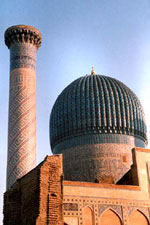 Places
of interest. The mausoleum of Ismail Samani (the Samanid Dynasty’s
founder) is a masterpiece of classical Eastern architecture.
Places
of interest. The mausoleum of Ismail Samani (the Samanid Dynasty’s
founder) is a masterpiece of classical Eastern architecture. 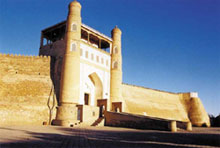 In
Sanskrit word, Bukhara signifies"monastery" and this city was once
a large commercial centre on the Great Silk Road. Bukhara was already
considered an important cultural and trade centre, which in fact
determined the dramatism of the city's historical fate.
In
Sanskrit word, Bukhara signifies"monastery" and this city was once
a large commercial centre on the Great Silk Road. Bukhara was already
considered an important cultural and trade centre, which in fact
determined the dramatism of the city's historical fate.